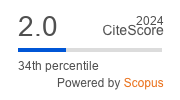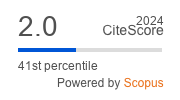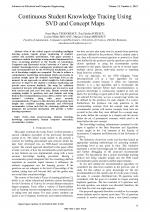| 1/2021 - 8 |
Continuous Student Knowledge Tracing Using SVD and Concept MapsTEODORESCU, O. M. |
| Extra paper information in |
| Click to see author's profile in |
| Download PDF |
Author keywords
data preprocessing, distance learning, knowledge representation, human computer interaction, recommender systems
References keywords
knowledge(14), systems(12), learning(11), response(6), education(6), data(6), theory(5), recommender(5), item(5), tracing(4)
Blue keywords are present in both the references section and the paper title.
About this article
Date of Publication: 2021-02-28
Volume 21, Issue 1, Year 2021, On page(s): 75 - 82
ISSN: 1582-7445, e-ISSN: 1844-7600
Digital Object Identifier: 10.4316/AECE.2021.01008
Web of Science Accession Number: 000624018800008
SCOPUS ID: 85102791484
Abstract
One of the critical aspects of building intelligent tutoring systems regards proper monitoring of student's activity and academic performance. This paper presents a continuous student knowledge tracing method implemented for Tesys e-Learning platform at the Faculty of Automation, Computers and Electronics in the University of Craiova. The student's knowledge level is continuously monitored and, after each recommended test by the SVD-based mechanism, a new set of knowledge weights are computed. We aim to achieve a comprehensive monitoring environment which can provide an accurate insight upon the student's knowledge level at any moment. In our approach, we added weights for both students and tests to improve the student's evolution monitoring and provide more accurate feedback. The setup for validation consisted of ten tests with eight questions per test and we used both current and past year tests data. Results revealed that assigning weights to questions, tests and students and using them in the recommendation process offers a better view of the student's evolution along with more accurate recommendations. Progress in this direction will provide more insight into available teaching materials and SVD-based recommender system such that the e-learning platform that integrates the presented mechanism will provide a better learning experience. |
| References | | | Cited By |
Web of Science® Times Cited: 1 [View]
View record in Web of Science® [View]
View Related Records® [View]
Updated 2 weeks, 5 days ago
SCOPUS® Times Cited: 1
View record in SCOPUS® [Free preview]
View citations in SCOPUS® [Free preview]
[1] Deep Knowledge Tracing Based on Spatial and Temporal Representation Learning for Learning Performance Prediction, Lyu, Liting, Wang, Zhifeng, Yun, Haihong, Yang, Zexue, Li, Ya, Applied Sciences, ISSN 2076-3417, Issue 14, Volume 12, 2022.
Digital Object Identifier: 10.3390/app12147188 [CrossRef]
Disclaimer: All information displayed above was retrieved by using remote connections to respective databases. For the best user experience, we update all data by using background processes, and use caches in order to reduce the load on the servers we retrieve the information from. As we have no control on the availability of the database servers and sometimes the Internet connectivity may be affected, we do not guarantee the information is correct or complete. For the most accurate data, please always consult the database sites directly. Some external links require authentication or an institutional subscription.
Web of Science® is a registered trademark of Clarivate Analytics, Scopus® is a registered trademark of Elsevier B.V., other product names, company names, brand names, trademarks and logos are the property of their respective owners.
Faculty of Electrical Engineering and Computer Science
Stefan cel Mare University of Suceava, Romania
All rights reserved: Advances in Electrical and Computer Engineering is a registered trademark of the Stefan cel Mare University of Suceava. No part of this publication may be reproduced, stored in a retrieval system, photocopied, recorded or archived, without the written permission from the Editor. When authors submit their papers for publication, they agree that the copyright for their article be transferred to the Faculty of Electrical Engineering and Computer Science, Stefan cel Mare University of Suceava, Romania, if and only if the articles are accepted for publication. The copyright covers the exclusive rights to reproduce and distribute the article, including reprints and translations.
Permission for other use: The copyright owner's consent does not extend to copying for general distribution, for promotion, for creating new works, or for resale. Specific written permission must be obtained from the Editor for such copying. Direct linking to files hosted on this website is strictly prohibited.
Disclaimer: Whilst every effort is made by the publishers and editorial board to see that no inaccurate or misleading data, opinions or statements appear in this journal, they wish to make it clear that all information and opinions formulated in the articles, as well as linguistic accuracy, are the sole responsibility of the author.



